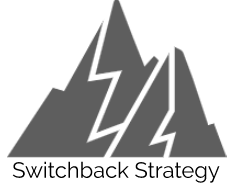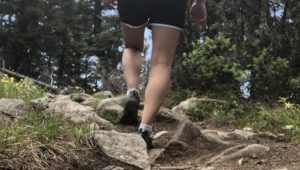Hiking at its root is a great frugal hobby, but it can become expensive over time. Camping and backpacking can be very gear intensive. Before you go shopping, I compiled a list of places to look to save some money.
Although there are definitely some necessary things you just need for a safe and comfortable trip, it is not necessary to have the newest, most high-tech gear available. I totally get concerns about the expense, but money shouldn’t be a deterrent from enjoying the outdoors. If you are feeling strapped for cash, I have shared my tips for where to look for cheap gear. I will also link to some specifics I’ve found that I though were a great buy.
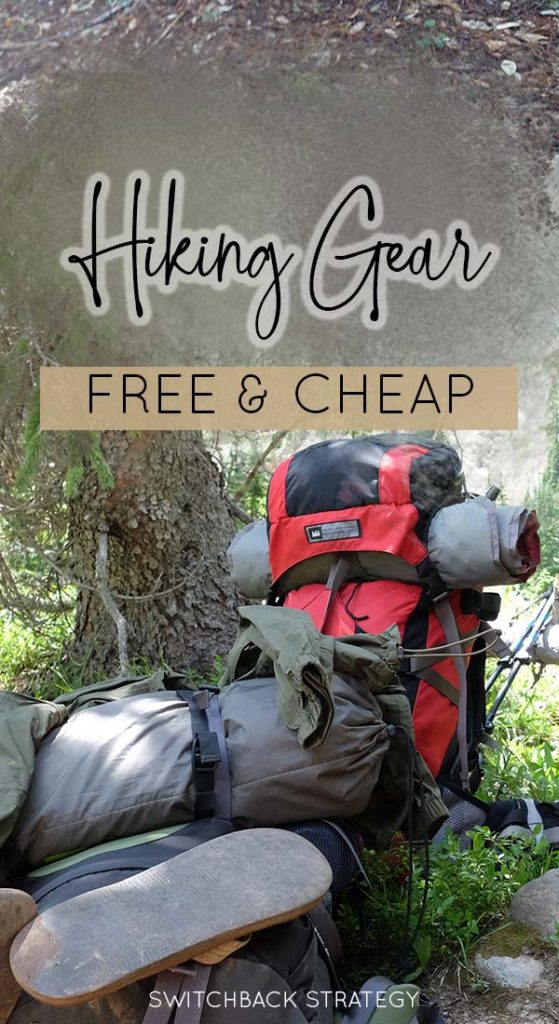
Disclosure: This post may contain affiliate links, which means I may receive a small commission, at no cost to you, if you make a purchase through a link on this blog. I would never recommend a product I don’t use or love myself.
1. Use what you have
The cheapest gear is – FREE. You may be able to find a lot of what you need just lying around the house.
Comfortable shoes are the first thing that you need. Running shoes will generally work (unless maybe you are going to be carrying a lot of weight or if you have an injury).
A school backpack may not be the most comfortable to carry long distances, but it will work for short day trips. Good enough to get you started at least. Eventually, you may want something more sturdy and with waist straps, like this osprey day pack. It helps for longer distances to get any weight off of your shoulders. But you shouldn’t need it on day one.
Water bottles can be anything that you have available, an old soda bottle, Gatorade bottle, smart water bottle, plastic squeeze bottle, or s’well bottle would all work well.
Skip the expensive foods and use things for snacks that you have or would otherwise use readily at home. If you need help, I have a list of snacks to get you started, many of which you may already have.
What to wear? any active gear made of synthetics that you have at home, as long as it’s comfy and you don’t mind it getting dirty. Just make sure that you have good shoes and socks. Socks may be the one thing you look at purchasing early, you will want to make sure that you have good quality hiking socks. Good socks are moisture-wicking to prevent blistering.
Get creative. A long stick can be used for a hiking pole. A piece of cloth can be a bandana. Utilize the things around you until you feel that it isn’t working for you anymore.
Gear: Basic essentials in the introductory phase to hiking
2. Borrow from a friend
If you don’t have something, ask a friend. Even better, bring them along with you. You can often borrow something for free and it’s a great way to try things out. Joining a hiking group or club can link you with people who share a similar interest, that you could plan trips with, and that may have some of the things you would need. Communicate and share things with other people going on the trip so that you don’t have to duplicate. If you do borrow, be sure to take good care of other people’s things, return them clean, and in a timely manner. Throwing in a 6-pack to say “THANKS” goes a long way, especially if you want to borrow again.
Gear: Usually non-specific/non-perishable things are your best bet, a tent, sleeping bag, backpack, stove, chair, kitchen gear, hiking poles, rope, cooler, bear canister
3. Find things used
Thrift stores (like Goodwill) usually have warm layers and sometimes outdoor gear.
Online sites like geartrade.com, facebook marketplace, craigslist, ebay, Patagonia’s Worn Wear can be an easy way to look for things from home.
Some of best deals have to be searched out: local garage sales, estate sales, REI garage sales, rental gear being sold (at the end of the season outdoor outfitters sell off some of their gear, and you can score old rental gear), gear swaps (ski towns have annual ski swaps and some stores organize their own) – being a thrifty hunter can pay off big.
We have a local outdoor gear exchange store that is awesome, they have good quality gear at a great price, and better yet the guys that work there are an excellent resource. The staff not only help me get setup with what I need, but also get me pointed in the right direction, offer suggestions, and give tips.
Just remember when buying used, ask for lots of pictures and confirm that no parts are missing.
Gear: Just about anything you can’t find for free, tent, sleeping bag, backpack, stove, chair, sleeping pads, cooler, chair, hiking poles. More person-specific things like gloves, clothing and crampons are a good bet.
4. Buy during the off season
If you do need to buy something new, try to shop during the off season, you can usually find better sales. There are online sites that sell discounted brand-name outdoor gear.
Steep and cheap and Backcountry have sales on big name brands like Arc’Teryx, Patagonia, and North Face, up to 70% off.
Try looking on:
Just be aware that if you sign up for the email updates it can be all too tempting to keep buying stuff just because there is a sale going on. And there is always a sale going on.
Black Friday Sale’s are good to look out for, and REI has it’s Anniversary sale in May.
Gear: Socks and underwear always fall into this category for me. And anything else that I just can’t find.
Some Great Gear Finds
In truth, a lot of what I have was either a hand-me-down or was found used. I bargain shop as much as possible, but there are a few things that I bought because it was just a great value, and they have lasted and worked well for us.
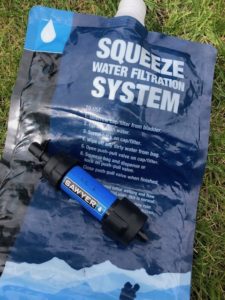
Water Filter
The Sawyer Mini Water Filter is a great value. It is lightweight, easy to pack, durable, and easy to use.
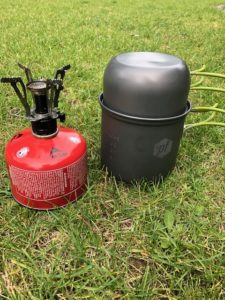
Backpacking Stove
This Petforu stove and cookset works with the MSR isopro fuel canisters. You may find more efficient options, but coming in at 1/3 the price it’s a great value buy.
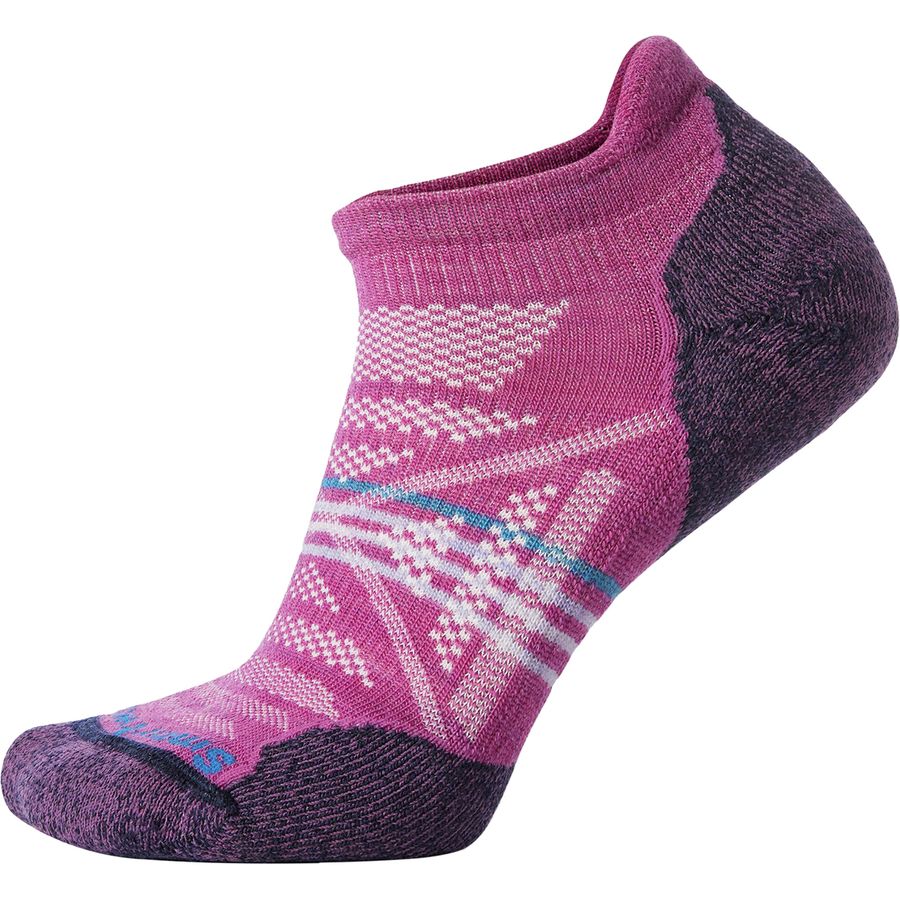
Hiking Socks
Having good socks is so worth it. These hiking socks from Smartwool aren’t the cheapest, but they are definitely comfy. Some things are worth the price.
5. Value Shop
You can find some crazy cheap items at discount stores like the Dollar Store, Target, TJ Max. There are some things you can buy cheap and it won’t make or break your day.
Gear: bandaids, bandanas, rain poncho (another alternative for this is a trash bag), water bottle, trekking poles (I got mine from Costco for around $20), sunglasses, sunblock, bug spray, and food. If you can find a good deal on it, take it.
However, there are a few things you don’t want to skimp on, like good socks, good shoes, and an accurate map.
6. Sample Sales
Big brands have sales a couple times a year to clear out the shelves. Clothing will be the most common find. It may be things going out of style, old colors, have slight imperfections, or have been slightly used as models.
Gear: Usually clothing
7. Utilize your phone
Cell phones can be used as a map, a compass, a tool to track your distance, and a camera. Although it’s not the best you can get, it’s a good start. Just be careful you are not overly reliant on it, trails often don’t have reception, and they are not always entirely accurate.
8. Rent
Renting is a good option if you want to try something new without fully committing to an expensive purchase. You should have a limit on this though, as renting can become very expensive. For items that are non-specific, like tents, sleeping bags, water filters, even backpacks, etc., I highly recommend asking around and you can often find what you need for free. Renting is best when things are very specific to you, or if you are looking for a very specific item. Try it out first, and if you find you love it, then start looking to make a purchase on sale.
Some examples of things I have rented are mountaineering boots, cross-country skis/boots, snow shoes, large yeti cooler for a summer dessert trip. And to be honest, I still haven’t bought any of that stuff myself. So for $20 a year it’s been worth it to rent when I needed it.
9. When you do make big ticket purchases – make sure it comes with a good warranty.
Sometimes you’ll find you have to spend money to expand your interest. Explore cost savings options first, but if you do buy something big, make sure you really like it, that it works well for you, and that it comes with a good warranty program. This will ensure that you can make a long term investment and won’t have to replace it often.
Some reputable companies to buy from are:
-
-
- REI
- Black diamond
- Osprey
- Thermarest
- Deuter
- MSR
- Solomon
-
Ramping up your gear
You should have an idea of the value added to the cost, and focus on things that will provide the most value at the lowest cost.
Shoes and Socks are the first things that would go on this list. If you don’t have good moisture wicking socks and comfortable shoes, those 2 things are going to make the most drastic difference.
If you are going to start backpacking, the first thing you need would be a backpack. Having a comfortable backpack that fits you can definitely improve your trips. I used a hand-me-down that was too big for 5 years before I upgraded, but when I finally did I was wondering why I had held out for so long. Backpacking can start to get expensive. It is extremely important to be appropriately prepared. But just don’t get too carried away with having the newest and lightest of everything.
Planning your Trip
You know what they say… location, location, location.
Looking for trails around your home is a great place to start. County and state parks are good options. The great thing about county and state parks is that the trails are well maintained, they are usually marked clearly, have good views and vistas, and many of them are free to access.
Things to consider:
- Start easy
- Plan out your trip in detail
- Check the weather
National Parks often provide unique landscapes, stunning views, and can be extremely well established and maintained. They do have entrance fees though, usually it’s per car. If you are looking for a weekend getaway, a state or national park could be an incredible cost friendly, fun family trip.
For planning out your trips, here are a few resources for maps and guides:
-
-
- Library – they often carry travel guides, books on trails, survival, foraging, history, and photography, and maps that are free to access and can sometimes be rented.
- alltrails – really easy source for finding and planning out hiking trips, the paid version allows you to download maps and access them offline
- Hiking Project – another really great resource for getting hiking trips planned and finding out what is available in your area, with reviews and maps to help guide.
- National Parks Service
- America’s State Parks
- Google Maps
- Free Campsites
-
Whereas hiking is quite simple, camping and backpacking can be very expensive. Google any ultralight gear and it is definitely not cheap. Just remember that having the latest gear straight off the shelf won’t make you a better woodsman. There are some necessities you have to have, you definitely don’t want to be ill prepared for your adventure, but that doesn’t mean that it has to be brand new, or top of the line, it just has to work well for you.
Happy trails my frugal friends.
